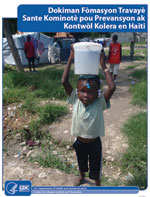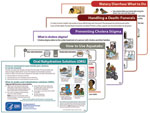Volume 17, Number 11—November 2011
THEME ISSUE
CHOLERA IN HAITI
Dispatch
Cholera Prevention Training Materials for Community Health Workers, Haiti, 2010–2011
Abstract
Stopping the spread of the cholera epidemic in Haiti required engaging community health workers (CHWs) in prevention and treatment activities. The Centers for Disease Control and Prevention collaborated with the Haitian Ministry of Public Health and Population to develop CHW educational materials, train >1,100 CHWs, and evaluate training efforts.
Because cholera can kill within hours of disease onset and access to cholera treatment centers is poor in many developing countries, community health workers (CHWs) are vital for educating community members about cholera transmission, prevention, and control and, when necessary, providing life-saving treatment. CHWs are typically laypersons selected by the community (1,2). For CHWs to effectively educate and support their communities during a cholera outbreak, they must be appropriately trained.
Cholera outbreaks typically arise in settings where water, sanitation, and hygiene infrastructures are inadequate (3). Even before Haiti was ravaged by an earthquake in January 2010, only 63% of the population had access to improved water sources, and only 17% had access to improved sanitation (4). Therefore, when the cholera outbreak began in October 2010, the Haitian Ministry of Public Health and Population (MSPP) was still actively developing and rebuilding the public health and water, sanitation, and hygiene infrastructures, and many communities were beyond the reach of these services. From the onset, MSPP initiated 3 strategies to enhance care of patients during the cholera epidemic: reinforcing existing heath care facilities with training and supplies, establishing a network of cholera treatment centers for management of severe cases, and mobilizing CHWs who could take treatment and prevention activities into the community.
The community-level strategy was particularly important in Haiti. A rapid assessment early in the outbreak indicated that among 87 cholera decendents, 39 (45%) died in the community, 60 (69%) did not suspect their illness was cholera or recognize the severity, 22 (26%) lived too far from health facilities to access care, and 30 (77%) of the 39 community decedents did not take oral rehydration solution (ORS) at home (J. Routh, pers. comm.). Populations with poor access to health care often experience higher case-fatality rates during cholera epidemics, which means that local provision of treatment and supplies through less specialized health workers such as CHWs is essential (5–9).
To assist CHWs in conducting cholera education, prevention, and treatment activities, a multidisciplinary team that included physicians, behavioral scientists, epidemiologists, engineers, and communication specialists at the Centers for Disease Control and Prevention (CDC) and MSPP developed a set of technically accurate, lower literacy, and culturally adapted training and educational materials for CHWs during the cholera outbreak in Haiti. The materials are comprehensive in scope and can be adapted for use in cholera preparedness and response activities in other countries.
Training materials were based on the World Health Organization technical guidelines for cholera; guidelines and educational materials from the International Centre for Diarrhoeal Disease Research, Bangladesh; cholera prevention messages, guidelines, and materials from CDC; online manuals and guides from various nongovernmental organizations; and information from manufacturers of point-of-use water treatment products. Consensus for all materials was reached among CDC subject matter experts and communications personal, MSPP, and CDC staff in Haiti. Amendments were made after field review and use in Haiti, and messages concerning culturally appropriate burial practices, stigma prevention, and additional water treatment options were added as the epidemic progressed and additional content needs were identified.
The materials now include comprehensive cholera prevention, treatment, and control training modules (Figure 1; Table 1, Table 2); a training guide and presentation slide set for use in teaching CHWs; and community education cards and low-literacy posters for CHWs to use within the community (Figure 2). Materials are available in Haitian Creole, French, and English.
As part of CDC’s response to the cholera outbreak in Haiti, this manual was made available through both CDC’s emergency website (www.cdc.gov/haiticholera) and cholera-specific website (www.cdc.gov/cholera). As of July 27, 2011, the websites had received >6,300 total views and 1,352 downloads. The training manual was also included as an appendix to CDC’s national clinical cholera training course for medical staff in Haiti, which was initiated on November 15, 2010.
CDC supported MSPP in organizing a Train-the-Trainer workshop March 1–3, 2011, in Port-au-Prince, Haiti. Twenty-four master trainers, including physicians, nurses, and other health care providers, were selected from various partner organizations and MSPP regional entities with large CHW cohorts. After the master trainers completed the Train-the-trainer course, they were asked to train CHWs within their own organizations in a cascading training approach. In June 2011, CDC conducted a preliminary follow-up evaluation of the Train-the-trainer course among master trainers to learn how it had contributed to subsequent trainings of CHWs. Participants included representatives from 9 departments and all partner organizations who attended the March Train-the-trainer workshop.
Survey questionnaires were completed by 14 of the 24 original Train-the-trainer participants. Among these, 8 participants reported training a total of 1,144 CHWs before the March Train-the-trainer course. Additionally, 10 participants reported training 1,170 CHWs in 9 departments of Haiti in the 3 months after the March Train-the-trainer event. Among the 10 participants who trained CHWs after the Train-the-trainer course, 9 reported using the CDC/MSPP CHW manual; 7 reported using the CDC/MSPP community education cards; and all demonstrated how to use soap, water treatment products, and ORS. Nine reported providing the CDC/MSPP manual to CHWs during trainings, 8 distributed water treatment products and ORS, and 7 distributed soap. All of those who trained CHWs after the March Train-the-trainer session reported that by the end of the training, CHWs were able to successfully demonstrate handwashing techniques, and most (9) indicated that CHWs were able to demonstrate proper preparation of safe water and ORS. In addition, 12 of the 14 participants who completed surveys reported training other types of community workers, including midwives, professors, group leaders, nurses, brigadiers, promoters, voodoo priests, and other religious leaders.
In an attempt to quickly and efficiently reach the most underserved areas of Haiti during a deadly cholera outbreak, we developed comprehensive training materials for CHWs and implemented training using a Train-the-trainer model. However, this process had many challenges. The urgent need for training in Haiti required us to draft messages without the benefit of formative research or pilot testing of the materials. Translating materials into Haitian Creole, which only became an official language in Haiti in 1987 and which remains a predominantly verbal language with several dialects, was difficult and required multiple quality assurance steps. Because of resource constraints, Train-the-trainer events were not initiated in Haiti until March 2011, >4 months after the epidemic began. More timely training might have helped mitigate the impact of the epidemic on remote and underserved populations. These materials can now be adapted to train CHWs in other cholera-affected countries more rapidly than we were able to do in Haiti. Additional evaluation activities are planned at the community and household levels to assess the impact of these materials on cholera knowledge, prevention activities, and treatment among CHWs and community members and to guide revisions of these materials.
In many rural areas of Haiti, CHWs are the backbone of the health care system and can play an essential role in preventing cholera illness and death among medically underserved populations. We prepared standardized materials and training modules for CHWs that focused on prevention, treatment, and control of cholera. We conducted a Train-the-trainer workshop that led to training CHWs across 9 departments of Haiti. Additional monitoring and evaluation activities are needed to assess the reach and impact of the training materials and implementation.
Ms Rajasingham is an epidemiologist with a background in environmental engineering at CDC, Waterborne Disease Prevention Branch. Her research interests include point-of-use water treatment technologies and their use in diarrheal disease prevention.
Acknowledgment
Special thanks to MSPP, Eric Mintz, Michael Beach, Rana Hajjeh, Rick Gelting, Melissa Etheart, Roodley Archer, Mary Neumann, Amy Parker, Hodelin Rene, John Guilford, Leslie Hausman, Dana Pitts, CDC’s Joint Information Center, and the team at CDC’s Creative Services, including Curt Wommack, Robert Hobbs, Dan Higgins, Kevin Clark, Jennifer Hulsey, James Archer, and Howard Hall.
References
- World Health Organization. Community health workers: what do we know about them? 2007 [cited 2011 Mar 20]. http://www.who.int/hrh/documents/community_health_workers.pdf
- World Health Organization and Global Health Workforce Alliance. Global experience of community health workers for delivery of health related millennium development goals: a systematic review, country case studies, and recommendations for integration into national health systems. 2010 [cited 2011 Mar 22]. http://www.who.int/workforcealliance/knowledge/resources/chwreport/en/index.html
- Guerra F. American and Filipino epidemiology, 1492–1898 [in Spanish]. Madrid: Ministry of Health and Consumption; 1999.
- World Health Organization and United Nations Children’s Fund. Progress on sanitation and drinking water: 2010 update [cited 2011 Mar 20]. http://www.wssinfo.org/fileadmin/user_upload/resources/1278061137-JMP_report_2010_en.pdf
- Quick RE, Vargas R, Moreno D, Mujica O, Beingolea L, Palacio A, Epidemic cholera in the Amazon: the challenge of preventing death. Am J Trop Med Hyg. 1993;48:597–602.PubMedGoogle Scholar
- Baqui AH, Yunus M, Zaman K. Community-operated treatment centers prevented many cholera deaths. J Diarrhoeal Dis Res. 1984;2:92–8.PubMedGoogle Scholar
- Faruque AS, Eusof A. Medical care utilization prior to death in cholera outbreaks in rural Bangladesh. Trop Doct. 1986;16:87–9.PubMedGoogle Scholar
- Tauxe RV, Holmberg S, Dodin A, Wells J, Blake P. Epidemic cholera in Mali: high mortality and multiple routes of transmission in a famine area. Epidemiol Infect. 1988;100:279–89. DOIPubMedGoogle Scholar
- Siddique AK, Akram K, Islam Q. Why cholera still takes lives in rural Bangladesh. Study of an epidemic. Trop Doct. 1988;18:40–2.PubMedGoogle Scholar
Figures
Tables
Cite This ArticleTable of Contents – Volume 17, Number 11—November 2011
| EID Search Options |
|---|
|
|
|
|
|
|


Please use the form below to submit correspondence to the authors or contact them at the following address:
Anu Rajasingham, Centers for Disease Control and Prevention, 1600 Clifton Rd NE, Mailstop C09, Atlanta, GA 30333, USA
Top